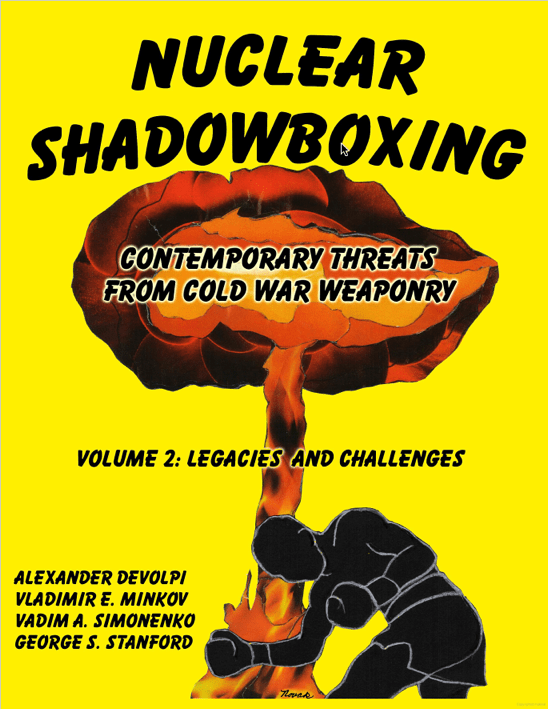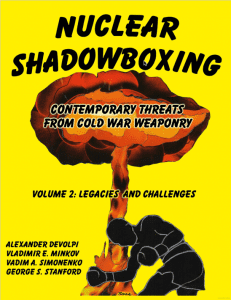Radiation, Pollution and Radiophobia
While researching answers to comments made on the Atomic Insights post titled Healthy doses of radiation, I found a book titled Nuclear Shadowboxing: Legacies and Challenges.
It includes a fascinating appendix titled Radiation, Pollution and Radiophobia that should be required reading for people who are interested in understanding more about the health effects of low level radiation, who want access to a useful single page table full of radiation-related conversion factors and who want to understand more about the fifty-five year old scientific, political and economic controversy over the use of the linear, no-threshold (LNT) dose assumption that is sometimes translated as “no safe dose” of radiation.
The document asks the following rhetorical questions.
Why do radiation-protection authorities have a public dose limit as low as 1 mSv per year? This is less than half of the average annual dose, and under 1 percent of doses in some countries? Why does the world spend billions of dollars per year to maintain the standard?
Before providing the list of answers that the document provides to its own question, I need to remind people of a principle derived from double entry accounting – one person’s cost is another person’s revenue. For every extra dollar spent to protect against ever smaller doses, someone collects one more revenue dollar than they would have collected if the dollar had not been spent.
Extra spending by utilities and governments — actually by taxpayers and ratepayers — is not the only effect of excessively strict radiation dose standards. Those standards — applied selectively to doses that can be traced to industrial sources of radiation and generally not applied to naturally occurring sources often associated with coal, oil and gas extraction and consumption — add a substantial cost penalty to nuclear-related products and services. Without those artificial costs and schedule-slowing impositions, nuclear-related products would be more serious competitors to products offered by established, non-nuclear vendors.
There are many tens of billions of dollars per year in sales at stake related to the assumption that every dose of radiation, no matter how small, is harmful. It is no wonder that resistance to change in this area is so virulent.
Here is a list of factors as provided in Radiation, Pollution and Radiophobia (pg. Va1-6) that make radiation health effects such an emotionally, economically and politically charged issue. I might have made some changes in the listing order, but it is a pretty comprehensive list.
Factors that have helped create of sustain radiophobia include the following:
- government insensitivity in testing nuclear weapons in the air, underground, above ground and at sea;
- emotional impact from using atomic bombs over Hiroshima and Nagasaki;
- excesses of the Cold War nuclear-arms race and the accompanying psychological warfare;
- demonstrably false projections of casualties made after the Three Mile Island and Chernobyl-reactor accidents;
- negative lobbying by fossil-fuel industries;
- crass interests of radiation researchers for recognition and budget allocations;
- self-serving politicians using radiophobia as a weapon in seeking power;
- misleading “dirty bomb” scares by careless analysts;
- public fear induced by news media that profit by hyping news;
- counterproductive interests of “greens” (psuedo-environmentalists) who thrive by scaring the public; and
- undue complacency and laxity within the nuclear industry.
Nuclear Shadowboxing was published in 2005, six years before the Fukushima Frenzy, so it is clear that the information it includes in the six concise pages of Appendix Va1 has not yet been distributed widely enough to make a difference.
Though I am probably stretching the fair use principle, I think it is important to make Radiation, Pollution and Radiophobia available as widely as possible. I encourage those who are intrigued by this sample of the book to go and purchase a copy; it is available in print and at a very affordable price as an e-book from Google Play.



Excellent set of factors. I have long said that the incessant exposure to the entire population of the US to “duck and cover” and images of nuclear attack (through movie shorts, TV shows, training films, books sent to homes and even included in “welcome wagon” distribution) have made it so that, at least in the US, people are more likely to associate a nuclear accident with the effects of nuclear war than they are to associate these effects with anything else, including – as you like to call them – industrial accidents. They just don’t generally have any different frame of reference. It’s not entirely their fault.
I have a big pile of both Civil Defense training material (for the general population) and Radiological Defense training material (for those who actually would have performed the many services that would have been required when Civil Defense was in full swing should we have been attacked) and it’s exceedingly important to note that EVEN THEN the goal was never, ever to reduce dose to zero. It was to minimize exposure as much as possible but zero dose was never achievable in those situations and never would have been attempted. Now, some can (and will) argue for days about the efficacy of the whole program, etc. but my point in bringing this up is to say that a fair review of all the material shows that fear based on the nuclear war scenario is also unfounded when we talk about low doses. The material just comes right out and says “no effects below X dose.” Failure to really understand minimizing dose leads to the idea “well the best thing is zero then” which leads to ALARA and all sorts of other things. As you well know, Rod.
I might have to get this book!
Hey…maybe we should start equating radiation exposure to alcohol. You know — two beers, no problem. Five beers – might feel it the next morning. Five beers and a couple shots – guaranteed hangover. Will need aspirin. Add another beer and shot and you’re calling off work. All the way up the scale to death induced by excessive alcohol consumption. The point is you have no effect from just a little.
Now, look at the studies that are showing that “one glass of wine a day reduces cholesterol.” Or other such things – reduces chance of heart attack, etc. It’s hormesis! Well, sort of. You get the idea. People could understand this analogy.
Just a thought, anyway.
-Will Davis
Thanks for noting the book. It is/was a new one on me. I went to the “google books” page you linked, and there’s a “preview this book” button. I clicked it and the entire appendix you reference is posted!. Good stuff.
“Hey…maybe we should start equating radiation exposure to alcohol. You know — two beers, no problem. … People could understand this analogy.”
An outrageously “simple” and lay-comprehensive health equivalence impact perspective analogy LONG LONG overdue for the public. If such went the Madison Ave mass media Ad route, nuclear’s Darth Vader image in the U.S. would do a 180 in weeks (actually there’s NO excuse this couldn’t be promoted by various outfits so PR-equipped in the nuclear community). I also regret that “Nuclear Shadowboxing” (under a less ominous, more educationally inviting title) can’t be disseminated free out the public and schools and any media fair enough to listen. It’d be well worth the nuclear community’s while.
James Greenidge
Queens NY
Seconded throughout, especially the need for a title – and artwork – change.
When I was interviewing people while researching “Power to Save the World”, scientists and radiation experts often said that contractors for nuclear sites push especially hard to build more protective barriers, just in case of some sort of catastrophic event.
One plan, for the Yucca Mt. Project, involved not only storing spent nuclear fuel deep inside the mountain in thick-walled casks but also putting titanium-alloy drip shields over each cask, just in case in 10,000 years enough water in that arid desert managed to drip so much that the concrete casks were breached, permitting radionuclides to eventually trickle out of the mountain and cross the desert and wind up in Yucca, a town 12 miles away with 1500 inhabitants. The contractors pushed hard for this plan, because it meant $millions more.
crass interests of radiation researchers for recognition and budget allocations;
On that note there was a particularly irritating NYT “article” recently. More of a shakedown really.
Concerns Over Measurement of Fukushima Fallout ( http://www.nytimes.com/2014/03/17/world/asia/concerns-over-measurement-of-fukushima-fallout.html )
With respect to its title I was thinking it would have at least one example of legitimate “concerns.” Alas no.
The original title was even worse: ” Squelching Efforts to Measure Fukushima Meltdown ” but I see they issued a correction.
And the NYT would do well to reflect on the thoughtless nature of that original headline, because it could well be part of what is making Japanese institutions cautious about free debate. I doubt that they will. It is a minor comfort that the NYT actually changed the headline – perhaps a sharp response from the Japanese embassy encouraged it.
The tendency of media institutions to look for dramatic scare stories is part of the problem, not part of the solution.
Well cutting to the chase I googled the author and seeing the streaming heap of anti nuke work I think the piece was more about trying to make a fringe “research” element like Mousseau and others look legit by involving more respected researchers like Ken Buesseler, who incidentally, as involved with a private organization as he is, is always going to be asking for more money and transparency.
“The Chronicle of Higher Education” – seems like the anti nukes will hide behind ANYTHING.
Meant to say “steaming heap,” but streaming works too though considering the amount and rate its been turned out.
On another note Monbiot has started to tackle Biogas. He compares it to offshore wind in his article so you can imagine how it does against real beseload energy. ( http://www.monbiot.com/2014/03/14/the-biogas-disaster/ ). I imagine the discussion will come up a lot more.
He is right too. It is a total disaster.
It appears to be a failure associated with the idea that if some is good, more is better. (Exact same story with fuel ethanol in the USA, for that matter.)
@John T Tucker
A reader sent me a link to a pretty good takedown of Mousseau – https://www.triumf.info/wiki/pwalden/index.php/Mousseau_at_the_Helen_Caldicott_Symposium%2C_March_11%2C_2013
I’m working to get permission to republish it as a guest post.
The Helen Caldicott Symposium. He/she deserves a medal just for attending. It is worth a read. I dont understand how Mousseau is still on the professional/media radar after what he has claimed.
I find the part about the scatter in results important. Many biological studies I’ve seen until now about the effect of radiation seem to have very large scatter, and I’m afraid most physicians don’t understand how much this puts in doubt the statistical calculation they do. The equations they use to calculate probabilities rely on the distribution of the noise being a normal distribution, but if it’s not the case, then the P value they calculate has no meaning at all. But if their measurement was behaving normally, there should not be that much scatter.